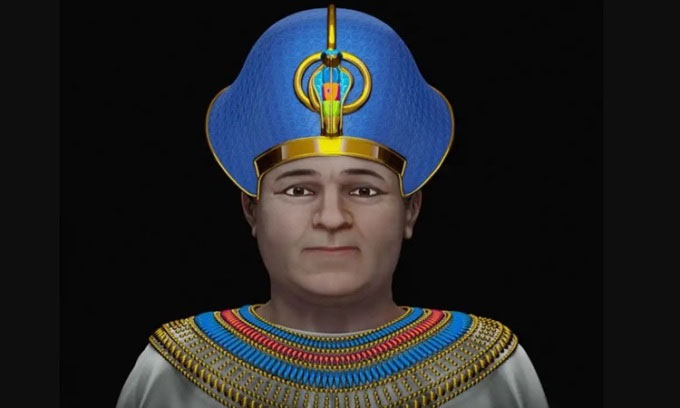Successfully reconstructed the portrait of pharaoh Tutankhamun's grandfather
Researchers recreated the portrait of pharaoh Amenhotep III, believed to be one of the wealthiest men in history.
Amenhotep III was one of the greatest pharaohs and has more surviving statues than any other king. He led Egypt through a period of unprecedented prosperity and power. Using data from the mummy skull of Amenhotep III, an international research team revealed his portrait for the first time in nearly 3,400 years , Mail reported on May 16.

Pharaoh Amenhotep III in reconstructed image. (Photo: Sun).
Michael Habicht, an archaeologist at Flinders University, Australia, commented that the reconstructed image looks quite different from the pharaoh's appearance on the statues. "That is the calm face of a man who promoted peace and lived in a time of economic prosperity. He may have been one of the richest people in history, at least at that time. Research progresses published in the 1970s described Amenhotep III as fat, quiet, almost bald and suffering from dental disease in his later years. His height was about 1.56m, among the smallest kings that we know from their preserved mummies," Habicht said.
Brazilian graphics expert Cicero Moraes, who recreated the pharaoh's portrait, said the reconstruction process began with a digital reconstruction of Amenhotep III's skull, using photographs and data about the mummy. . He used additional data from donors to estimate the size and position of the king's ears, eyes, nose, and mouth.
"Based on historical information, Amenhotep III had a muscular appearance, which is why we used data from individuals with a high body mass index. Compared to the portraits of other pharaohs I have participated in restored, this is the most complete portrait since we modeled both the clothes and accessories ," Moraes shared.
Pharaoh Amenhotep III was highly revered when he was alive. He died between the ages of 40 and 50, passing on the Egyptian kingdom at its peak of prosperity and power to his son, pharaoh Amenhotep IV. His grandson Tutankhamun became one of the most famous pharaohs thanks to the discovery of an intact tomb in 1922. Habicht, Moraes, colleagues Elena Varotto from Flinders University and Francesco Galassi from the University of Lodz in Ba Lan will publish her research in scientific journals.
- The 'different' portrait of Pharaoh Tutankhamun
- Scans of 3,000-year-old Egyptian pharaoh mummies, uncovering stunned secrets
- Artificial intelligence helps to successfully reconstruct the face of the Egyptian pharaoh from a mummy
- First reconstructed the mummy face 2600 years old
- Egypt plans to move the treasures of Pharaoh Tutankhamun
- Portrait of the penguin was extinct 25 million years
- The death of the last Pharaoh
- Effort to save Leonardo Da Vinci's self-portrait
- The mysterious trumpet carries the curse of the Egyptian pharaoh
- Find the mysterious crypt of Pharaoh Seti I
- Drawings in the youngest pharaoh tomb in Egypt reveal concussion
- Pharaoh 'rises': Close up of the great 3,000-year-old sight of Egypt
 Discovered an ancient centipede fossil 99 million years old
Discovered an ancient centipede fossil 99 million years old Discovered bat-like dinosaurs in China
Discovered bat-like dinosaurs in China Discovered a 200-year-old bronze cannon of the coast
Discovered a 200-year-old bronze cannon of the coast Discover 305 million-year-old spider fossils
Discover 305 million-year-old spider fossils